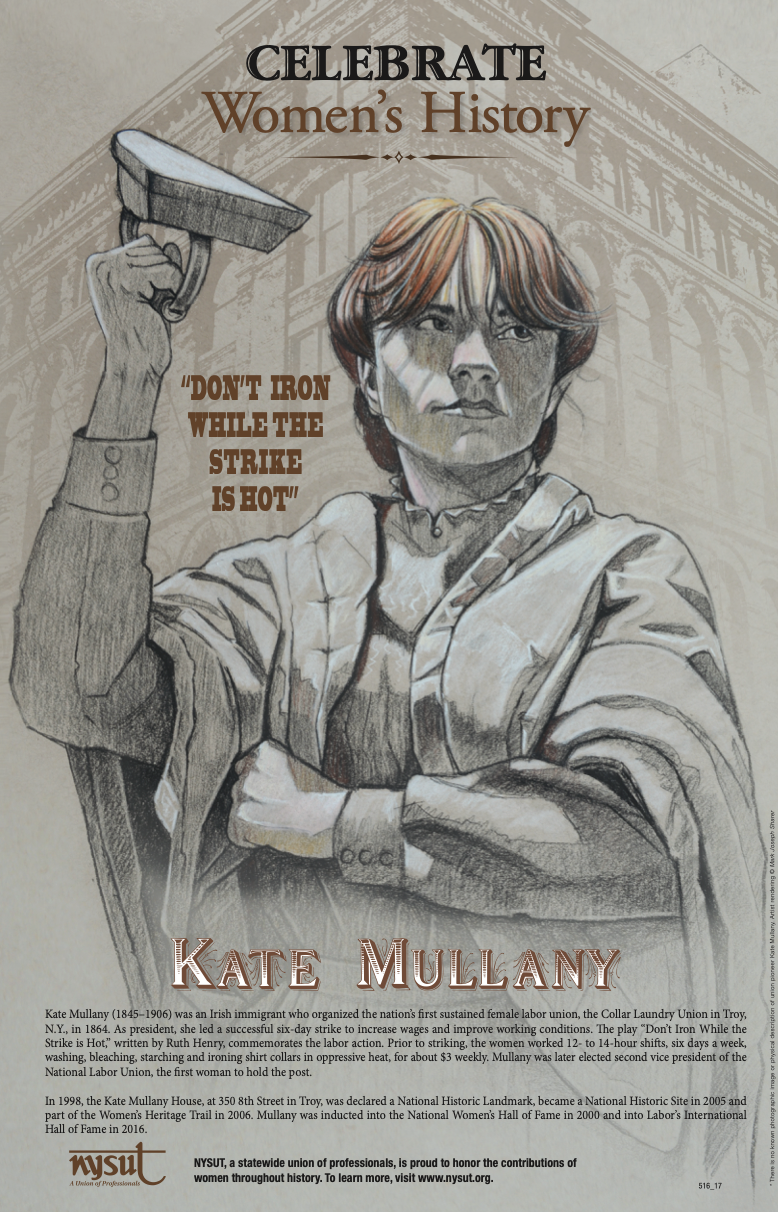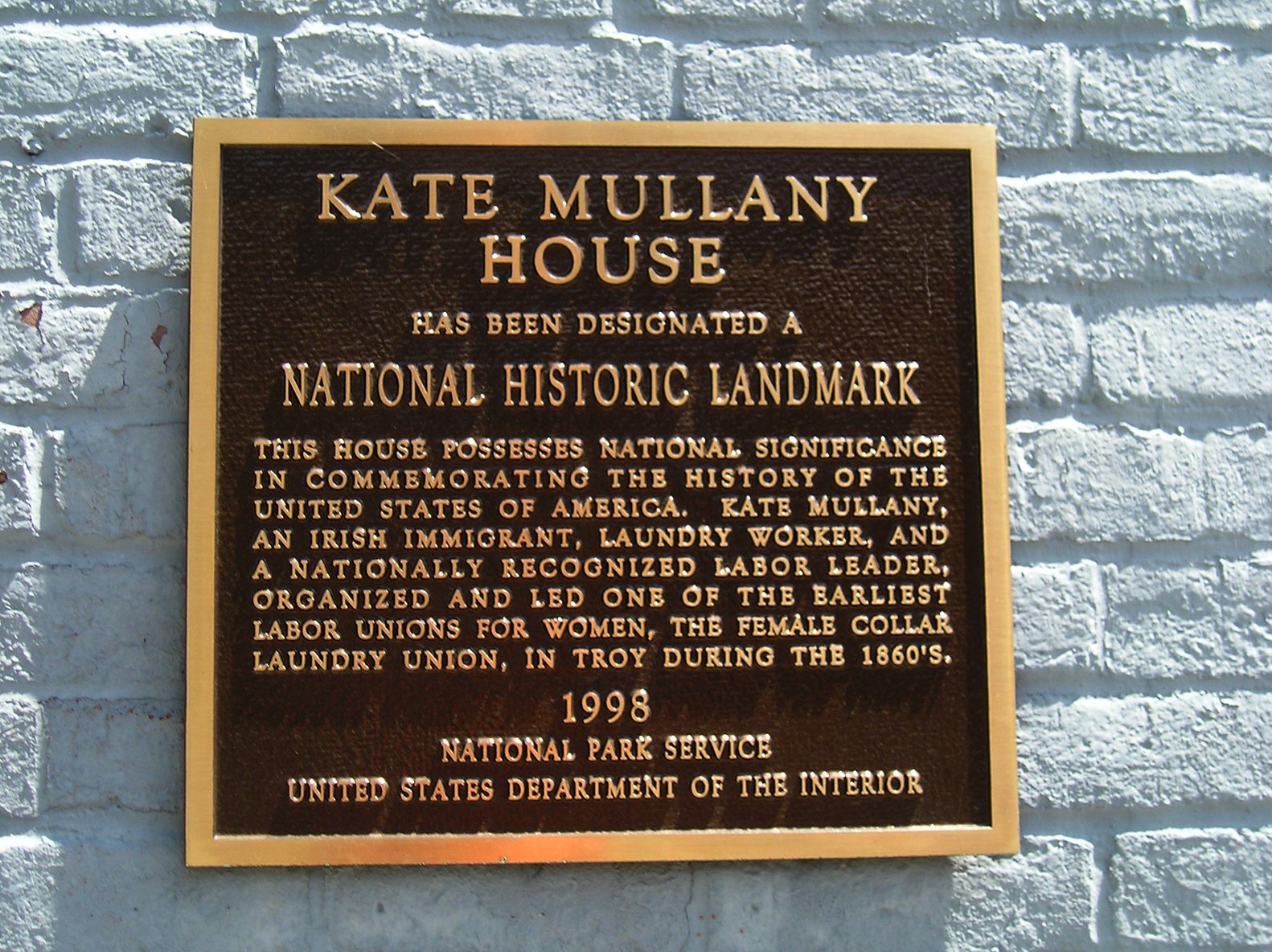Kate Mullany's former home in Troy, New York honors one of the earliest women's labor unions that sought fair pay and safe working conditions.
-
September 2023
Volume68Issue6

At the newly opened Kate Mullany House, a National Historic Site in Troy, New York, there is a display of the various flatirons that laundresses in the 19th century used in service to the city’s “collar and cuffs” industry. Among them is a coal-fired iron with a compartment for burning coals. As the coals cooled, they were inflamed with a bellows. What could go wrong?
Made of solid iron and weighing up to 10 pounds, the irons are slightly sinister artifacts of “women’s work” as it once was.
Flatirons were used to smooth linen, cotton, and wool clothing, a laborious household chore. But, for those women who earned their living as laundresses, working conditions were much worse than tedious. “Laundry girls” toiled 12 to 14 hours a day, standing at ironing tables and washtubs set beside furnaces, and molding steaming, wet fabric in 100-degree heat.
Laundering also involved handling caustic cleaners and fuels such as lye, sulfuric acid, and kerosene. After the collars were washed in boiling water by hand, they were bleached with chloride of soda, washed again with soap, rinsed and rolled, then starched, and finally ironed. Severe burns and other injuries were common. Fatalities were not unusual.
Wages were pitiful: two or three dollars a week. If a shirt, collar, or cuff was damaged, the cost came out of the employee’s pay. Dropping a collar on the floor resulted in a fine. Laundering became more dangerous with the introduction of scalding, mechanized starching machines that required almost as much effort as hand-starching.
Even so, competition for laundry jobs was fierce. In Troy and other northeastern cities, laundry girls were mostly Irish immigrants who were willing to take any job, without complaint. That was until Kate Mullany, a 19-year-old collar laundress, decided that enough was enough.
She was born in England to Irish parents. The family immigrated to New York City in 1850, and, like thousands of Irish immigrants before them, they eventually traveled 150 miles upriver to Troy, a small but prospering city, in search of work. Not long after, Kate’s father died. Her mother was in poor health, requiring Kate’s sister to care for her and their three younger siblings. Kate took on the responsibility of being the family's breadwinner. Nearly half of Troy’s female work force, about 3,700 women, worked in the city’s 14 commercial laundries. Kate became one of them.
In the 19th century, Troy was the fourth-wealthiest city per capita in the country. Its financial might was propelled by water power from nearby rivers and canals, and its mills, foundries, and manufacturing ingenuity put the city at the forefront of the Industrial Revolution. Textiles were an increasingly important part of the city’s output from the 1820’s on, especially the high-collared, white starched shirts that were the height of fashion for middle- and upper-class men. That same decade, according to city lore, a Troy housewife, Hannah Montague, invented the detachable collar. Tired of washing her husband’s shirts when only the collar was soiled, she cut the collars off, washed them, and reattached them with string.
The idea quickly caught on, with collars being attached by cufflink-like studs. A decade or so later, detachable cuffs entered the market. By 1860, detachable collars and cuffs were a mainstay of men’s wardrobes, and Troy textile companies produced 90 percent of them nationwide. Large fortunes were made, but the laundry trade remained a grueling, poorly paid occupation.

As Mullany was undoubtedly aware, there was resistance to the idea of a female union from all classes of men. Society took a dim view of women working at all, and working-class men generally believed that women employees would depreciate the value, and the wages, of their own labor. Undaunted, Mullany drew inspiration from the local Iron Molders International Union, and gained their cooperation and support. She organized her fellow laundresses, about 300 of them, and during the frigid month of February in 1864, she and her co-worker Esther Keegan led a weeklong strike that resulted in a 25-percent wage increase and improved working conditions. After the success of the first strike, the ad-hoc organization doubled in membership and became the Troy Collar Laundry Union.
A second strike brought wages to $14 a week. Mullany and her family built a three-story, brick, double-row house with her increased wages. They lived in one apartment and rented out the others.
In 1868, she traveled to New York City to attend the National Labor Congress at Germania Hall. Among the other three representatives from New York was Susan B. Anthony, who would later write about Mullany’s union activities. Kate was praised by delegates for her determination, organizational abilities, and her humanitarian efforts on behalf of her fellow unionists. On the last day of the congress, President William Sylvis appointed her as Assistant Secretary—making her the first woman to be named to a national labor union office. Chief among her tasks was the coordination of national efforts to form workingwomen’s associations, a duty she was dedicated to for many years.
In his closing speech, Sylvis described Mullany as “one of the smartest and most energetic women in America, and from the great work she has already done, I think it not unlikely that we may in the future have delegates representing 300,000 working women.”

But captains of industry were not easily thwarted in their drive for ever-larger profit margins, and the invention of paper collars put an end to the gains in the laundry trade. The Troy Collar Laundry Union was dissolved in 1870. Susan B. Anthony wrote sympathetically about the union and Mullany’s “working women’s ventures,” even though Mullany was not interested in politics and declined to join the mostly middle-class suffragist movement. Instead, she and her union officers started a cooperative laundry and a cooperative collar-and-cuffs factory. But these initiatives failed under the relentless pressure and bullying tactics of local factory owners, who collaborated in preventing the cooperatives from getting work.
Not much is known about Mullany’s later years. She lived in Buffalo and married John Fogerty, an iron molder, in 1883. After being widowed, she returned to the brick row house in Troy where her sister still lived. She died there in 1906 at 65.
Mullany may have been forgotten, if not for the efforts of the non-profit American Labor Studies Center, which owns the house and spent 35 years restoring it to its 1860s configurations.
“This was not poverty housing, but worker housing, and they were proud of it,” said Paul Cole, director of the Labor Center. In 1998, through the efforts of Cole and the site’s biggest advocate, then-First Lady Hillary Clinton, the Mullany House was listed as a National Historic Landmark. In her dedication speech at the site, Clinton said:

“When Kate formed that union, she knew she was taking a big risk … Most of the women who went on strike were the sole supporters of their mothers, of their younger siblings, or their children. Imagine the commitment to justice and courage it took to go on strike when so many family members depended on them. But, because of Kate Mullany’s leadership, they succeeded … putting their wages on a par with men’s wages, an astonishing achievement for 1864.”
In June, the Mullany House opened to the general public. It features displays on labor history on the first floor, the Labor Center’s office on the second, and a period-specific recreation of the Mullanys’ apartment on the top floor. During the opening festivities, Cole said that the significance of the house, a National Historic Site since 2004, is simply this: “It embodies the little-told tale of women in the labor movement.”

